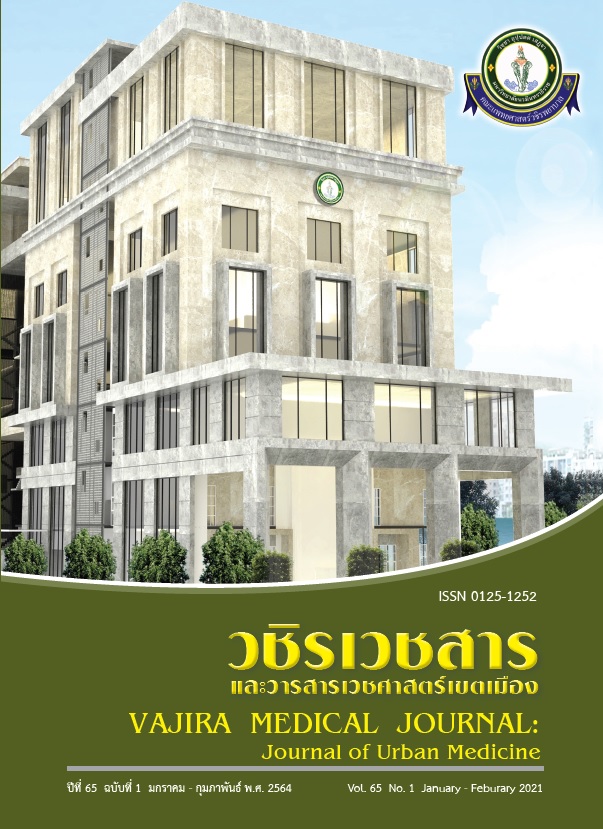Outcomes of Pharmaceutical Care in Asthmatic and COPD Patients at Faculty of Medicine Vajira Hospital, Navamindradhiraj University
Main Article Content
Abstract
Objectives: To study the outcomes of pharmaceutical care in the area of drug related problems, problem causes, intervention methods, intervention outcome and inhaler technique in the asthma and chronic obstructive pulmonary disease (COPD) patients.
Methods: This study was retrospectively descriptive study in patients diagnosed with asthma and COPD who receives the first prescription of new inhaler device from the out-patient department of Faculty of Medicine Vajira Hospital, Navamindradhiraj University between January 1, 2014 to December 31, 2018. Each patient received pharmaceutical care during the treatment of asthma and COPD. The outcomes were analyzed by descriptive statistics.
Results: There were 538 patients in this study, (282 females, 52.42%, and 257 males, 47.78%). This study identified 402 drug related problems (DRPs) in 311 patients (57.81%) with an average of 1.32 + 0.69 DRPs per patient. The most frequent problems were insufficient drug treatment [331 problems (82.34%)]. Most common causes were prescribing error (missing of necessary information) 219 causes (54.48%). The highest problem solving action was the change of drug prescription which was 235 times (58.46%). Pharmaceutical care interventions could resolve 395 problems (98.26%). From evaluation of inhaler technique, the most common misuse inhaler device by the patients were Respimat, Turbuhaler, Breezhaler, HandiHaler, Pressurized Metered-Dose Inhalers and Accuhaler, respectively.
Conclusion: The pharmaceutical care in this study was found to be effective to identify and solve the problems relating to drug use, which can assist the patients to use their medications appropriately.
Downloads
Article Details
References
Boonsawat W, Charoenphan P, Kaitboonsri S, Wiriyachaiyoo V, Pothirat C, Wongtim S, et al. Survey of asthma control in Thailand. Respirology 2004; 9: 373–8.
Regional COPD Working Group. COPD prevalence in 12 Asia-Pacific countries and regions: Projections based on the COPD prevalence estimation model. Respirology 2003; 8: 192-8.
Tan WC, Ng TP. COPD in Asia: Where East Meets West. Chest 2008; 133: 517-27.
Global Initiative for Asthma. Definition, description, and diagnosis of asthma. In: Hadfield R, editor. Global strategy for asthma management and prevention. Bethesda, MD: National Heart Lung Blood Institute; 2018. p. 13-21.
Global Initiative for chronic obstructive lung disease. Definition and overview. In: Hadfield R, Hess M, editors. Global strategy for the diagnosis, management, and prevention of chronic obstructive pulmonary disease. Bethesda, MD: National Heart Lung Blood Institute; 2019. p. 1-15.
Masoli M, Fabian D, Holt S, Beasley R. The global burden of asthma: executive summary of the GINA dissemination committee report. Allergy 2004; 59: 469-78.
Bemt PM, Egberts TC, Berg LT, Brouwers JR. Drug-related problems in hospitalised patients. Drug Saf 2000; 22: 321-33.
Leape LL, Cullen DJ, Clapp MD, Burdick E, Demonaco HJ, Erickson JI, et al. Pharmacist participation on physician rounds and adverse drug events in the intensive care unit. JAMA 1999; 3: 267-70.
Sanchis J, Gich I, Pedersen S. Systematic review of errors in inhaler use: has patient technique improved over time? Chest 2016; 150: 394-406.
Thamkampee K, Joothong S, Jourjamsai N, Roonsrithong N, Chalermchai N, Lawthong C. Treatment for asthma patients in hospitals affiliated with the Ministry of Public Health. Thai J Tuberc Chest Dis Crit Care 2008; 26: 235-42.
Van der Palen J, Thomas M, Chrystyn H, Sharma RK, van der Valk PD, Goosens M, et al. A randomised open-label cross-over study of inhaler errors, preference and time to achieve correct inhaler use in patients with COPD or asthma: comparison of ELLIPTA with other inhaler devices. NPJ Prim Care Respir Med 2016; 26: 1-8.
Shrestha M, Parupia H, Andrews B, Kim SW, Martin MS, Park DI, et al. Metered-dose inhaler technique of patients an urban ED: prevalence of incorrect technique and attempt at education. Am J Emerg Med 1996; 14: 380-4.
Luedphanithit N. Outcomes of pharmaceutical care in patients with chronic asthma at Dokkhamtai hospital. JHS 2014; 23: 37-44.
Fink JB, Colice GL, Hodder R. Inhaler devises for patients with COPD. COPD 2013; 10: 1–13.
Kurathong S. Urban Medicine. Vajira Med J 2016;59: 1-4.
Hepler CD, Strand LM. Opportunities and responsibilities in pharmaceutical care. Am J Hosp Pharm 1990; 47: 533-43.
Pharmaceutical Care Network Europe Foundation. PCNE classification for drug related problems V6.2 [internet]. 2010 [cited 2016 January 15]. Available from: http://www.pcne.org/upload/files/11_PCNE_classifiation_V6-2.pdf.
Kawamatawong T, Kaewwan S. Inhaler devices in asthma and chronic obstructive pulmonary disease. Bangkok: Harnthai pharma; 2015. p.1-26.
Lertsinudom S. The use of anti-asthmatic drugs. In: Lertsinudom S, editor. Pharmaceutical care in asthma. Khonkaen: Klungnana; 2009. p. 34-57.
Bower L, Barnhart S, Betit P, Care AAFR. AARC Clinical practice guideline: selection of an aerosol delivery device for neonatal and pediatric patients. Respir Care 1995; 4(12): 1325-35.
Dalby R, Spallek M, Voshaar T. A review of the development of Respimat Soft Mist Inhaler. Int J Pharm 2004; 283(1-2): 1-9.
Alagusundaram M, Deepthi N, Ramkanth S, Angalaparameswari S, Saleem TM, Gnanaprakash K, et al. Dry powder inhalers-an overview. Int J Res Pharm Sci 2010; 1(1): 34-42.
Phanphao W, Jenghua S, Supamoon W, Nakham A. Intervention on managing drug related problems in hospitalized patients with asthma and chronic obstructive pulmonary disease (COPD) in Buddachinnaraj Phitsanulok hospital. NUJST 2005; 13(1): 51-9.
Kitpaiboontawee S. Pharmaceutical care in general medical ward at middle-level hospital. Reg 11 Med J 2017; 31(3): 369-83.
Khiawwan S. Development of a teaching service system for using inhaled brochodilators in patients with respiratory diseases. Rama Nurs J 2019; 25(2): 130-47.


